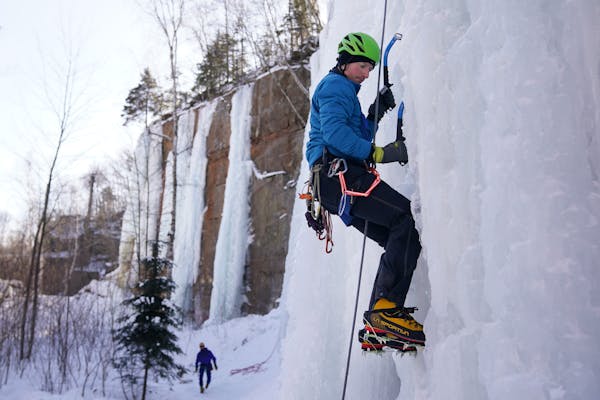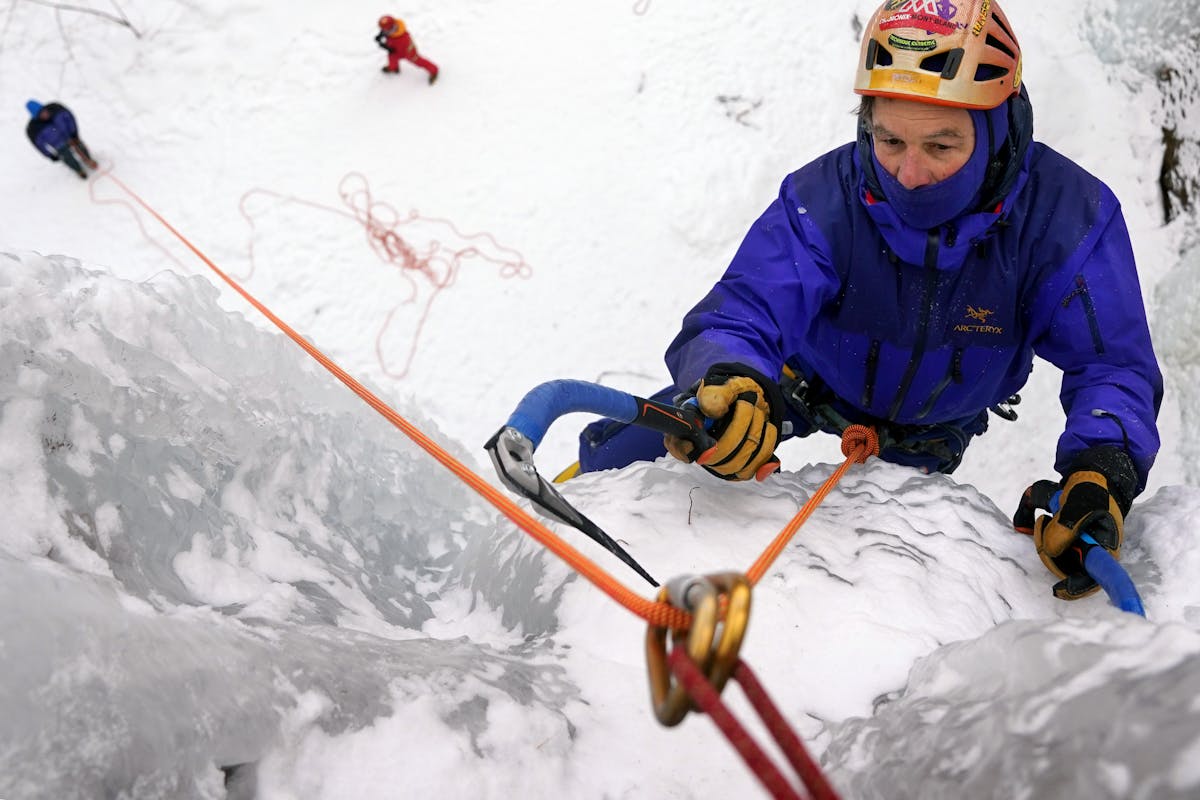Taking exercise outside and switching up your activities offers surprising benefits.
My ax made a satisfying thwack into the ice as I pulled myself up, the crampons on my boots digging into the frozen cliff.
“How’s the view from up there?” my guide called.
“Beautiful!” I yelled. And it was — from the ice-covered quarry walls of Sandstone’s Robinson Park, I looked out over the snowy Kettle River, a high trestle bridge spanning in the distance. The valley below, encased in a layer of white, mirrored the cloud-filled sky.
It was an amazing, only-in-winter moment.
Getting there wasn’t easy, though. During my first attempt at ice climbing, I gave up halfway, the tips of my fingers stinging with cold because I’d been gripping my axes too tightly. It was a newbie mistake — one that climbers call the “screaming barfies,” said my guide Tony Vavricka, who owns climbing and rafting outfitter Hard Water Sports.
Embrace Winter
30 day Challenge
For the Embrace Winter Challenge, our goal is to spend at least 30 minutes outside each day. On the coldest days, feel free to break your time into several short forays. And if the temperature and windchill are stuck in dangerous lows, consider it a free day. Start tracking your time, using whatever’s handy — a calendar, a journal or your phone’s Notes app. You also can print out a free tracking poster from 1,000 Hours Outside.
On my next ascent, I was able to relax my grip and make it to the top of the ice-covered sandstone cliff.
“You only have to do it once — you can talk about it for the rest of your life,” Vavricka said after my successful climb.
I may do it again. But just trying a new winter sport was exhilarating.
Exercising outdoors in winter isn’t always such a thrill, but it offers some hefty benefits, said Beth Lewis, who runs the Exercise and Mental Health Lab at the University of Minnesota’s School of Kinesiology.
“We need to be active all year round. But you see seasonal affective disorder and more anxiety, depression in the winter, and I think that’s a time when we really can embrace exercise, even more so,” said Lewis.
As part of the Embrace Winter Challenge, our goal is to spend at least 30 minutes outside, every day. This week, we’re asking you to try a new-to-you winter sport or activity.
We know that exercise boosts mental and physical health. Studies also show that being outdoors is a plus. First off, exercise doesn’t feel as difficult al fresco.
Lewis pointed to studies that looked at the heart rate of people exercising and how hard they felt they were working. “And people do have that perception that it’s not as hard outside,” she said. “People also report enjoying it more outside than inside, for the most part.”
Sunshine — which can increase serotonin levels and vitamin D — also gives outdoor exercising the edge.
“There’s some data to show that it’s actually better for your mood to be outside versus inside,” said Lewis. “There’s also data to show that if you’re around interesting things to look at, you are more likely to adhere to an exercise program.”

Gallery: Ice climbing is the perfect cold weather activity
Winter also gives us an opportunity (or, in some cases, forces us) to switch up our activities, which can help keep us moving. When winter comes, she recommends you greet it by telling yourself, “ ‘Wow, this is my opportunity to snowshoe for a couple of months.’ Then you’re excited to go back to running again after you’re done.”
Instead of being an interruption, using the seasons to change up your activities is a plus.
“Changes in your activity are related to higher adherence to exercise because you’re decreasing boredom and increasing how much you enjoy it,” said Lewis.
Is there one best exercise for winter? Some say cross-country skiing is the most efficient because it provides a whole-body workout. But Lewis said the best winter sport is the one you enjoy most, since you’re more likely to keep at it.
Dress for success
When you’re exercising outside — especially in winter — you need to think about safety.
For walkers and runners, the dark comes early. Wearing reflective clothing or a hat with a built-in light helps drivers see you. Traction cleats or running spikes offer stability in icy conditions. As can carefully picking a path, such as walking in the snow instead of an icy trail.
Dressing correctly is key. While different temperatures and levels of exertion require different gear, here are some basics:
Wear a wicking material (not cotton) as a base layer next to your skin. If needed, you can add insulating layers, then top if off with a wind block.
Mittens generally keep your hands warmer than gloves. A fleece balaclava or neck warmer will protect your neck and face. And you can’t go wrong with merino wool socks. If you’re prone to cold fingers and toes, bring along some heat packs.
If you’re like me and have trouble just getting out the door when it’s cold, take Lewis’ suggestion:
“Just tell yourself you’re going to go out for five minutes. And if it’s too cold, you’ll turn around and come back,” she said. “Most of the time, once you get out there and you get your heart rate going, you actually will not be out there for just five minutes.”
Embrace Winter Challenge three
Try a new-to-you winter sport

Lou Renner search for the final spot to drive in his ice axe as he topped out on an ice route Wednesday afternoon at Robinson Park. Photo by Anthony Souffle.
This week, try a winter sport that you’ve never done before. There are plenty of options. In addition to the old favorites (skiing, skating and snowshoeing), you could try ice climbing, curling, ice yoga, kubb, fat biking or even bhangra dancing in the snow. (Some may add ice fishing to this list, but I’m not sure it counts as exercise.)
Don’t let gear be an obstacle. Three Rivers Park District has gear for rent, including downhill skis, snowboards, cross-country skis, snowshoes, kicksleds and sleds. The Minnesota Landscape Arboretum rents snowshoes for its 11 miles of trails and the Trailhead in Theodore Wirth Park has cross-country skis and snowshoes for rent. Many bike shops, including Tangletown Bike Shop, rent fat tire bikes.
Many ice rinks are open, but some warming houses (which often have loaner skates) are closed. Maple Grove’s Central Park Ice Skating Loop, does have rentals.
“Think about what you’d like to do in the summer and you probably like to do that in the winter, as well,” said Beth Lewis, of University of Minnesota’s Exercise and Mental Health Lab. Lewis. “If you like to run, you probably like to snowshoe. If you like to bike, you probably like to winter bike,” she said.
Share action photos on Instagram using #StribMinnesota, or e-mail to erica.pearson@startribune.com.

